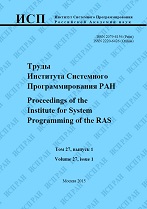|
DOOR: distributed object oriented software restructuring approach using neural network
A. Khan
COMSATS University Islamabad
Abstract:
To develop common software systems, engineers and designers are currently using an object-oriented approach that helps build distributed object-oriented systems. A distinctive feature of distributed object-oriented systems is the distribution of classes of objects among various nodes. Typically, there is no information about the distribution of classes across servers in applications, which encourages a restructuring procedure that improves productivity. In the proposed approach, software restructuring of distributed object-oriented systems is carried out using the adaptive method using a neural network. At the initial stage, a graph of class dependencies is created, in which nodes represent classes, and relations between nodes correspond to dependencies between classes. Then, the properties of the classes included in this graph are extracted, which are transmitted as input to the neural network for its training. After that, based on the account of class dependencies, clustering is performed, leading to the partition of the set of classes of the distributed object-oriented system into loosely coupled subsets. Next, a graph of clusters is created, the vertices in which correspond to clusters, and the edges correspond to communication channels that may exist between clusters. The k-medoids algorithm is applied to the resulting graph, which is used to collect the clusters in such a way that the number of collected cluster groups becomes equal to the number of available system nodes. The resulting cluster groups are loosely coupled. Finally, cluster groups are assigned to various available nodes in a distributed environment. The simulation results showed that the proposed work gives more effective results compared to existing methods.
Keywords:
distributed object oriented systems, class dependency graph, recursive graph clustering, low coupling, neural network, distributed architecture.
Citation:
A. Khan, “DOOR: distributed object oriented software restructuring approach using neural network”, Proceedings of ISP RAS, 31:5 (2019), 109–126
Linking options:
https://www.mathnet.ru/eng/tisp457 https://www.mathnet.ru/eng/tisp/v31/i5/p109
|

| Statistics & downloads: |
| Abstract page: | 104 | | Full-text PDF : | 39 | | References: | 9 |
|




 Contact us:
Contact us: Terms of Use
Terms of Use
 Registration to the website
Registration to the website Logotypes
Logotypes








 Citation in format
Citation in format 